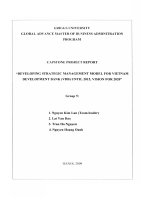Strategic management planning for domestic and global competition 14th ed pearce robinson chapter 9
Bạn đang xem bản rút gọn của tài liệu. Xem và tải ngay bản đầy đủ của tài liệu tại đây (474.93 KB, 33 trang )
Chapter 9
Multibusiness Strategy
© 2015 by McGraw-Hill Education. This is proprietary material solely for authorized instructor use. Not authorized for sale or distribution in any manner. This document may not be copied, scanned, duplicated, forwarded, distributed, or
posted on a website, in whole or part.
Learning Objectives
•
•
•
•
•
Understand the portfolio approach to strategic analysis and choice in multibusiness
companies.
Understand and use three different portfolio approaches to conduct strategic analysis and
choice in multibusiness companies
Identify the limitations and weaknesses of the various portfolio approaches
Understand the synergy approach to strategic analysis and choice in multibusiness
companies
Evaluate the parent company role in strategic analysis and choice to determine whether
and how it adds tangible value in a multibusiness company
2
The Portfolio Approach
•
•
The portfolio approach is a historical starting point for strategic analysis and choice in
multibusiness firms.
The portfolio approach helps allocate resources in multibusiness companies.
3
Portfolio Techniques
•
An approach pioneered by the Boston Consulting Group that attempted to help managers
“balance” the flow of cash resources among their various businesses while also identifying
their basic strategic purpose within the overall portfolio.
4
The BCG Growth-Share Matrix
Dimensions
•
Market Growth Rate
–
•
The projected rate of sales growth for the market being served by a particular business
Relative Competitive Position
–
The market share of a business divided by the market share of its largest competitor.
5
The BCG Growth-Share Matrix
Types of Businesses
•
Stars
–
•
Businesses in rapidly growing markets with large market shares.
Cash Cows
–
Businesses with a high market share in low-growth markets or industries.
6
The BCG Growth-Share Matrix
Types of Businesses (contd.)
•
Dogs
–
•
Low market share and low growth businesses
Question Marks
–
Businesses whose high growth rate gives them considerable appeal but whose low market share
makes their profit potential uncertain.
7
Ex. 9.2
The BCG Growth-Share Matrix
8
The Industry Attractiveness-Business Strength Matrix
•
•
This approach has a much broader focus than the growth-share matrix
•
It also has 9 cells instead of BCG’s 4 to allow for finer distinctions among
business portfolio positions.
It uses multiple factors to assess industry attractiveness and business strength
rather than the single measures employed in the BCG matrix
9
Ex. 9.4 Factors
Considered in Constructing an Industry Attractiveness-Business Strength
Matrix (adapted)
•
Industry Attractiveness
–
–
–
–
–
–
Nature of competitive rivalry
Bargaining power of suppliers/customers
Threat of substitute products/new entrants
Economic factors
Financial norms
Sociopolitical considerations
10
Ex. 9.4 Factors Considered in Constructing an Industry Attractiveness-Business Strength
Matrix (adapted)
•
Business Strength
–
–
–
–
–
–
Cost position
Level of differentiation
Response time
Financial strength
Human assets
Public approval
11
Ex. 9.5 The Industry Attractiveness-Business Strength Matrix
12
BCG’s Strategic Environments Matrix
•
•
•
This approach uses the idea that it was the nature of competitive advantage in
an industry that determined the strategies available to a company’s businesses,
which in turn determined the structure of the industry.
BCG believed that such a framework could help ensure that individual
businesses' strategies were consistent with strategies appropriate to their
strategic environment.
This allowed corporate managers in multiple-business companies one way to
rationalize which businesses they are in.
13
Ex. 9.6
BCG’s Strategic Environments Matrix
14
BCG’s Strategic Environments Matrix
Types of Businesses
•
Volume Businesses
–
Businesses that have few sources of advantage, but the size is large – typically the result of scale
economics
•
Stalemate Businesses
–
Businesses with few sources of advantage, most of them small. Skills in operational efficiency, low
overhead, and cost management are critical to profitability.
15
BCG’s Strategic Environments Matrix
Types of Businesses (contd.)
• Fragmented Businesses
• Businesses with many sources of advantage, but they are all small. They typically involve
differentiated products with low brand loyalty, easily replicated technology, and minimal scale
economies.
• Specialization Businesses
• Businesses with many sources of advantage. Skills in achieving differentiation (product design,
branding expertise, innovation, and perhaps scale) characterize winning specialization businesses.
16
Limitations of Portfolio Approach
•
•
•
•
•
•
It does not address how value is being created across business units
Truly accurate measurement for matrix classification was not as easy as the matrices portrayed
The underlying assumption about the relationship between market share and profitability
varied across industries and market segments
The limited strategic options came to be seen more as basic strategic missions
It ignored capital raised in capital markets
It typically failed to compare the competitive advantage a business received from being owned
by a particular company with the costs of owning it
17
The Synergy Approach: Leveraging Core Competencies
•
•
•
Opportunities to build value via diversification, integration, or joint venture
strategies are usually found in market-related, operations-related, and
management activities
Strategic analysis is concerned with whether or not the potential competitive
advantages expected to arise from each value opportunity have materialized
The most compelling reason companies should diversify can be found in
situations where core competencies—key value-building skills—can be leveraged
with other products or into markets that are not a part of where they were
created
18
The Synergy Approach
•
Each core competency should provide a relevant competitive advantage to the
intended businesses
•
Businesses in the portfolio should be related in ways that make the company’s core
competencies beneficial
•
Any combination of competencies must be unique or difficult to recreate
19
Elements Critical in Meaningful Shared Opportunities
•
The shared opportunities must be a significant portion of the value chain of the businesses
involved.
•
The businesses involved must truly have shared needs – need for the same activity – or
there is no basis for synergy in the first place.
20
The Parenting Opportunities Framework
•
The perspective that the role of corporate headquarters (the “parent”) in multibusiness (the
“children”) companies is that of a parent sharing wisdom, insight, and guidance to help
develop its various businesses to excel.
21
The Parenting Opportunities Framework (contd.)
•
•
•
The parenting opportunities framework perspective sees multibusiness companies
as creating value by
influencing—or parenting—their businesses
The best parent companies create more value than any of their rivals do or would if
they owned the same businesses
To add value, a parent must improve its businesses
22
The Corporate Parent Role:
Can It Add Tangible Value?
Realizing synergies from shared capabilities and core competencies is a
key way value is added in multibusiness companies.
1. Research suggests that figuring out if the synergies are real and, if so, how to
capture those synergies is most effectively accomplished by business unit managers,
not the corporate parent.
2. How can the corporate parent add value to its businesses in a multibusiness
company?
23
10 Sources of Parenting Opportunities
•
•
•
•
•
Size & Age
Management
Business Definition
Predictable Errors
Linkages
•
•
•
•
•
Common capabilities
Specialized expertise
External relations
Major decisions
Major changes
24
The Parenting Strategy Approach
According to BCG, corporate parents add value through five types of levers:
• Corporate functions and resources
• Strategy development
• Financing advantages
• Business synergies
• Operational engagement
25









